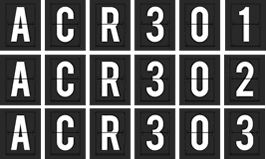How To Create Good Inventory Item Numbers
Designing Good Item Numbers For Products In Inventory
If You Have the Chance to Create Item Numbers From Scratch, Don't Screw It Up.
Item identification numbers (item numbers) are used to uniquely identify items that you carry in inventory. Some companies will call them "part numbers", "model numbers", "product codes", SKUs, etc. But whatever you call them, item numbers are important for you and the systems you use. If you or your system can't uniquely identify an item, you can't effectively account for its activity and whereabouts within your inventory. Item numbers also serve as a shorthand for longer item descriptions. Instead of entering an entire name or description for an item, you can use a much shorter item number. This speeds up the process of data entry and inventory management.

Retail products and big companies often use long and complicated numbers for their item numbers. These are fine if you're operating a complex warehouse or retail operation. And if this makes sense for your operation, then you probably already have a numbering scheme and don't need to read much further. But if you want to create a system that's easier to work with and uses your own item numbers, here are some of our recommendations.
Sign Up and Upload Your Inventory Spreadsheets
We'll configure your inventory, organize your data, and upload it in just a few hours.
All for Free for a Limited Time Only (No Credit Card Required)
Good Item Numbers Will Make Your Life Much Easier!
Tips on Creating Item Number Schemes
- Unless you are forced to do so by something out of your control, never start an item number with a zero. Just trust us on this.
- Avoid using letters that can be confused with numbers. The main culprits are O, I, and L.
- DO NOT use a manufacturer's serial number or part number for your part number. These numbers are often too long and cryptic. Plus, if you switch suppliers, or the manufacturer changes their number, it becomes meaningless to your organization.
- Keep item numbers short, but not so short that they could be mistaken for other numbers (i.e., quantities). 4 to 8 characters will suffice for most organizations.
- Do not load item numbers with meaning; do not try to use the item number to describe your product. This will only make your numbers longer and more complicated. Save this information for the item description.
- Consider using a few letters. Letters will help further distinguish your item numbers from other numbers, and they will greatly increase the number of possible item numbers you can have while keeping the overall item number length as short as possible.
- Using a few letters from the beginning of your item description at the beginning of your part number will make it much easier to look up items in pick lists. For example, if you were creating an item number for "Sauce, Chocolate", you might create the number "SAU101", "Sauce, Caramel" would be "SAU102", etc.
- Do not use characters that might confuse people or software. For example, using a comma in your inventory item number might make it look like a quantity or price. Using a "/" can result in Excel formatting your part number as a date. Symbols such as "<", ">", and "*" can have unintended consequences when moving data between Clearly Inventory and your spreadsheet program. Try to keep your item numbers simple and alphanumeric where possible.
How To Create Good Inventory Item Numbers
Source: https://clearlyinventory.com/resources/inventory-basics/how-to-design-good-item-numbers-for-products-in-inventory/#:~:text=Keep%20item%20numbers%20short%2C%20but,number%20to%20describe%20your%20product.
Posted by: jacksonsentin2001.blogspot.com

0 Response to "How To Create Good Inventory Item Numbers"
Post a Comment